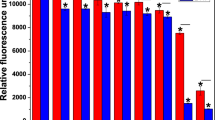Abstract
Chlorine addition as a biocide in seawater results in the formation of chlorination by-products such as trihalomethanes (THMs). Removal of THMs is of importance as they are potential mutagenic and carcinogenic agents. In this context, a study was conducted that used ionizing radiation to remove THMs from chlorinated (1, 3, and 5 mg/L) seawater by applying various dosages (0.4–5.0 kGy) of gamma radiation. Bromoform (BF) showed a faster rate of degradation as compared to other halocarbons such as bromodichloromethane (BDCM) and dibromochloromethane (DBCM). In chlorine-dosed seawater, total irradiation dose of 0.4 to 5 kGy caused percentage reduction in the range of 6.9 to 76.7 %, 2.3 to 99.6 %, and 45.7 to 98.3 % for BDCM, DBCM, and BF, respectively. During the irradiation process, pH of the chlorinated seawater decreased with increase in the absorbed dose; however, no change in total organic carbon (TOC) was observed. The results show that gamma dose of 2.5 kGy was adequate for maximum degradation of THM; but for complete mineralization, higher dose would be required.




Similar content being viewed by others
References
Abdel-Wahab A, Khodary A, Bensalah N (2010) Formation of trihalomethanes during seawater chlorination. J Environ Prot 1:456–465
Allonier AS, Khalanski M, Camel V, Bermond A (1999) Characterization of chlorination by-products in cooling effluents of coastal nuclear power stations. Mar Pollut Bull 38:1232–1241
American Public Health Association (2005) Standard methods for the examination of water and wastewater. 21st edn., Washington DC
Amro H, Tuffaha R, Zenati S, Jneidi M (2008) Remediation of polluted waters and wastewater by irradiation processing in Jordan. IAEA, Vienna
Barrett SE, Krasner SW, Amy GL (2000) Natural organic matter and disinfection by-products characterization and control in drinking water. In: ACS Symposium Series, vol 761. American Chemical Society; Oxford University Press, pp 270–281
Basfar A, Mohamed K, Al-Abduly A, Al-Shahrani A (2009) Radiolytic degradation of atrazine aqueous solution containing humic substances. Ecotoxicol Environ Saf 72:948–953
Black and Veatch Corporation (2010) Determination of chlorine residuals in water and wastewater treatment. White’s handbook of chlorination and alternative disinfectants, 5th edn. Wiley, New York
Bodzek M, Waniek A, Konieczny K (2002) Pressure driven membrane techniques in the treatment of water containing THMs. Desalination 147:101–107
Drzewicz P, Bojanowska-Czajka A, Trojanowicz M, Nałęcz-Jawecki G, Sawicki J, Wołkowicz S (2003) Application of ionizing radiation for degradation of organic pollutants in waters and wastes. Pol J Appl Chem 47:127–136
Getoff N (1986) Radiation induced decomposition of some chlorinated methanes in water. Water Res 20:1261–1264
Jenner HA, Taylor C, Van Donk M, Khalanski M (1997) Chlorination by-products in chlorinated cooling water of some European coastal power stations. Mar Environ Res 43:279–293
Kutty PM, Nomani AA, Thankachan TS, Al-Rasheed R, (1995) Studies on THMs formation by varios disinfectants in seawater desalination plants. In: IDA conference, Abu Dhabi. pp 1146–1162
Lal M, Mahal HS (1988) Free radical reactions of bromoform in air free and air saturated aqueous solutions: effect of pH. Radiat Phys Chem 32:599–603
Lew CS, Mills WB, Loh JY (1999) Power plant discharges of total residual chlorine and trihalomethanes into rivers: potential for human health and ecological risks. Hybrid Method Eng 1:19–36
Luks-Betlej K, Bodzek D (2002) Occurrence of trihalomethanes, particularly those containing bromine, in Polish drinking waters. Pol J Environ Stud 11:255–260
Mak FT, Zele SR, Cooper WJ, Kurucz CN, Waite TD, Nickelsen MG (1997) Kinetic modeling of carbon tetrachloride, chloroform and methylene chloride removal from aqueous solution using the electron beam process. Water Res 31:219–228
Puspalata R, LaVerne JA, Pimblott SM (2007) High dose radiolysis of aqueous solutions of chloromethanes: importance in the storage of radioactive organic wastes. J Nucl Mater 361:10–17
Rajamohan R, Vinnitha E, Venugopalan VP, Narasimhan SV (2007) Chlorination by-products and their discharge from the cooling water system of a coastal electric plant. Curr Sci India 93:1608–1612
Rajamohan R, Vinnitha E, Puspalata R, Venugopalan VP, Usha N, Murugesan V, Narasimhan SV (2012) Trihalomethane formation potential of drinking water sources in a rural location. Adv Environ Res 1:181–189
Rajamohan R, Venugopalan VP, Mal D, Usha N (2014) Efficiency of reverse osmosis in removal of total organic carbon and trihalomethane from drinking water. Res J Chem Environ 18:1–6
Saeed T, Khordagui H, Al-Hashash H (1999) Contribution of power and desalination plants to the levels of volatile liquid hydrocarbons in the nearby coastal areas of Kuwait. Desalination 121:49–63
Spinks JWT, Woods RJ (1990) An introduction to radiation chemistry. Wiley, New York, pp 285–288
US-EPA (1995) Determination of chlorination disinfection by-products, chlorinated solvents halogenated pesticides/herbicides in drinking water by liquid-liquid extraction and gas chromatography with electron capture detection. Cincinnati, Ohio
Acknowledgments
We thank Arvind for his assistance in sampling seawater for experiments.
Author information
Authors and Affiliations
Corresponding author
Additional information
Responsible editor: Philippe Garrigues
Rights and permissions
About this article
Cite this article
Rajamohan, R., Natesan, U., Venugopalan, V.P. et al. Removal of trihalomethane from chlorinated seawater using gamma radiation. Environ Sci Pollut Res 22, 18772–18778 (2015). https://doi.org/10.1007/s11356-015-5044-z
Received:
Accepted:
Published:
Issue Date:
DOI: https://doi.org/10.1007/s11356-015-5044-z




